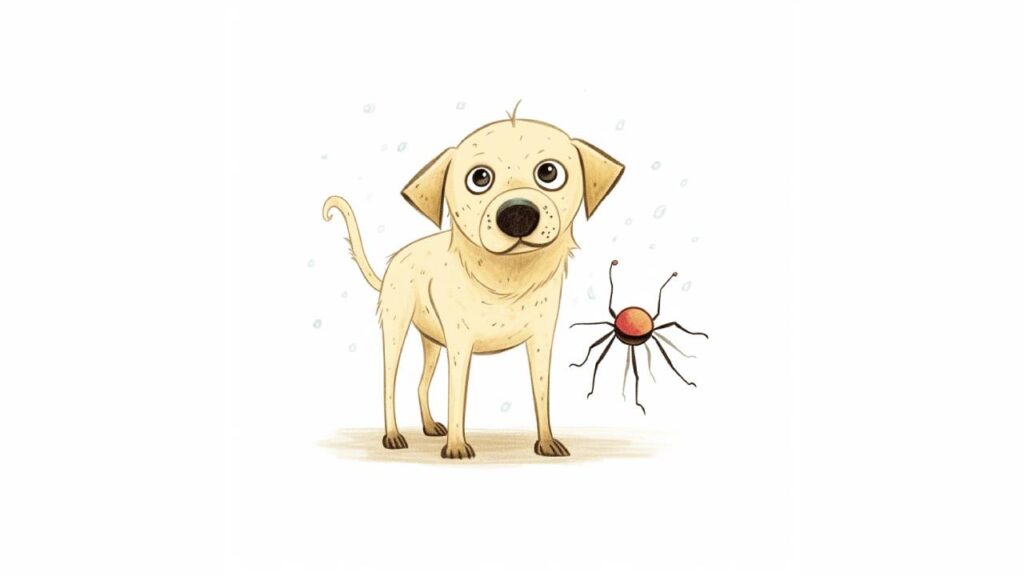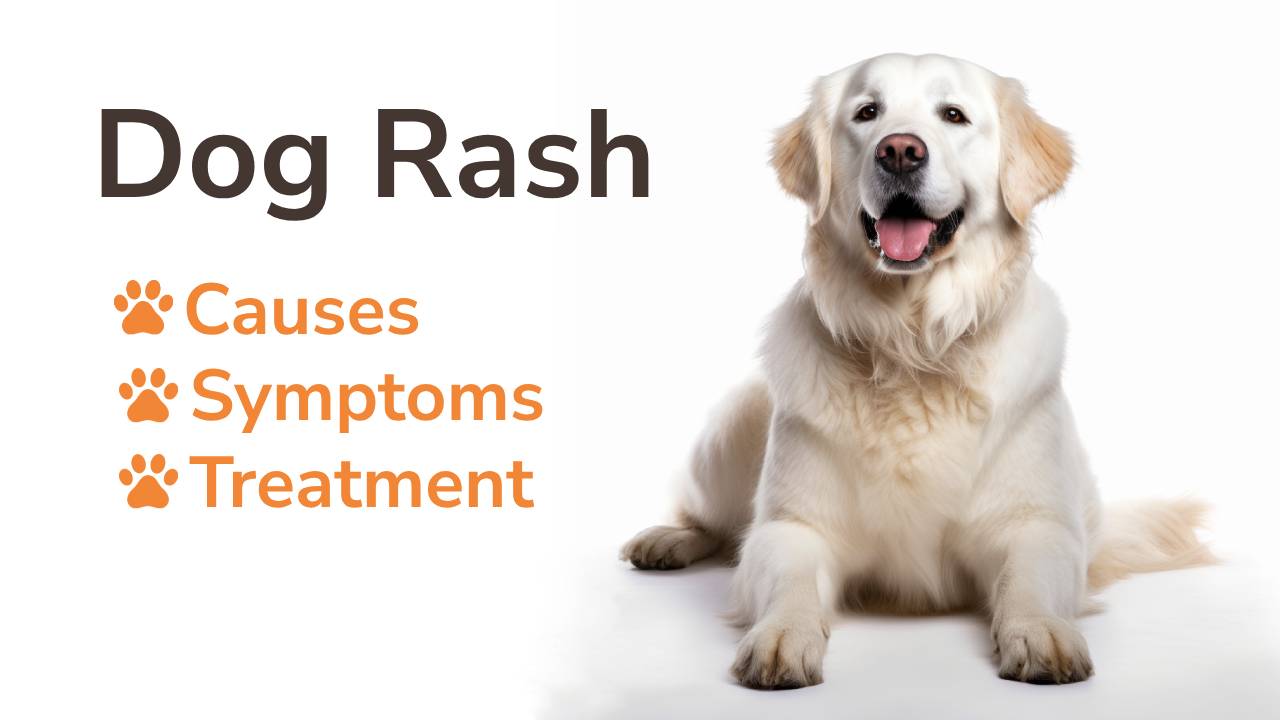As pet parents, we know our dogs’ well-being is our top priority. When a dog has a rash, it can be a cause for concern, leaving us feeling helpless and anxious.
Is there anything more distressing than seeing your beloved canine companion suffering from a rash? Imagine this: you’re out on a beautiful sunny day, walking your furry friend in the park.
Suddenly, you notice your dog scratching more than usual, and upon closer inspection, you see red, inflamed skin. Your heart sinks, and you wonder, “Why does my dog have a rash?”
A dog’s skin is as sensitive as it is resilient. Like us, they can experience various skin issues that lead to rashes and discomfort. Understanding the world of dog rashes is the first step in providing the care and relief your loving dog deserves.
Identifying Signs of a Dog Rash
Recognizing the signs of a dog rash is crucial in providing timely care for your devoted companion. Look out for the following indicators:
- Red, inflamed, or irritated skin
- Excessive scratching, licking, or biting of the affected area
- Presence of bumps, blisters, or pimples
- Hair loss or thinning in specific areas
- Unpleasant odor or discharge from the skin
- Changes in your dog’s behavior, such as restlessness or lethargy
If your dog exhibits any of these symptoms, promptly alleviating their discomfort and preventing the rash from worsening is vital.

Unravelling The Causes: What’s Behind Your Dog’s Rash?
The causes of dog rashes can be as diverse as the breeds themselves. Understanding the root cause is crucial in providing targeted care and treatment.
- Allergies
Allergies are a leading cause of rashes, affecting humans and our canine companions. Dogs can be allergic to various triggers, such as certain foods, environmental allergens like pollen or dust mites, or even specific grooming products.
Allergies can manifest as itchy skin, which leads to scratching and further irritation. Identifying and managing these allergies is essential for your dog’s well-being.
- Flea and Tick Infestations
Fleas and ticks are irritating and can transmit diseases to your dog. Their bites can lead to skin irritation, resulting in rashes and discomfort.
Flea infestations are widespread and can cause significant distress for your dog.
- Contact Dermatitis
Contact dermatitis occurs when your dog’s skin directly touches an irritating substance. This could be anything from plants and household chemicals to certain fabrics or grooming products. Contact dermatitis can lead to red, itchy rashes in areas of contact.
- Infections
Bacterial and fungal infections can cause skin irritation and lead to rashes. These infections may occur due to existing skin issues, like hot spots or injuries, which create an entry point for harmful bacteria and fungi.
Infections can lead to red, inflamed skin with possible discharge, boils, or abscesses. Prompt infection treatment is vital to prevent it from spreading to other normal areas.
- Environmental Factors
Environmental factors, such as extreme weather conditions or exposure to harsh elements, can also trigger skin irritation and rashes in dogs.
Weather-related rashes can cause dry, flaky skin, redness and irritation in exposed areas, and cracks or sores on paw pads.
- Genetics
Like humans, genetics can significantly influence a dog’s susceptibility to developing skin issues, including rashes. While genetics alone may not cause inflammation, it can make some dogs more vulnerable to specific triggers.
Certain breeds may have a predisposition to specific skin conditions due to their genetic makeup. For example, some breeds are more prone to allergies or autoimmune disorders, which can manifest as skin rashes.
- Hormonal Imbalance
Hormones regulate various physiological processes in a dog’s body, including the health of its skin and coat. Hormonal imbalances, such as those related to the thyroid gland or sex hormones, can lead to skin problems, including rashes.
For instance, hypothyroidism, a condition where the thyroid gland doesn’t produce enough thyroid hormone, can cause dry, flaky skin and hair loss, contributing to the development of rashes. Similarly, hormonal changes during a dog’s reproductive cycle can also affect their skin health.

Diagnosing Your Dog’s Itchy Mystery
Diagnosing the exact cause of your dog’s rash can be challenging and might need professional expertise. If your dog has an inflammation that persists for more than a couple of days or is accompanied by other concerning symptoms, it’s time to consult your veterinarian.
A veterinary examination will involve a thorough evaluation of your dog’s medical history, a physical exam, and, if necessary, diagnostic tests. Your vet may perform skin scrapings, cultures, or blood tests to pinpoint the underlying cause of the rash accurately.
Early detection and proper diagnosis lead to effective treatment and a happier, healthier dog.
Treating The Itch: The Path To Relief
Once you have identified the cause of your dog’s rash, the next step is to implement a targeted treatment plan. Treatment will depend on the specific issue your dog is facing. Follow your veterinarian’s advice for the best results.
Allergy Management
For dogs with allergies, identifying and avoiding the allergen is crucial. Your veterinarian may recommend an elimination diet to determine the specific food trigger or suggest allergy testing to identify environmental allergens.
Allergy management may involve:
- Avoiding known allergens.
- Providing a balanced diet with hypoallergenic ingredients.
- Using medicated shampoos or sprays to soothe the skin.
Parasite Control: Banishing Fleas and Ticks
Flea and tick prevention is essential to protect your dog from these pesky parasites and the rashes they can cause.
Parasite control measures include:
- Using veterinarian-recommended flea and tick preventives.
- Regularly checking your dog for fleas and ticks.
- Maintaining a clean and pest-free living environment.
- Medications and Topicals
In cases of infections, your veterinarian may prescribe antibiotics or antifungal medications to combat the bacteria or fungi responsible for the rash.
Administering prescribed medications as directed and using medicated shampoos or ointments can help alleviate symptoms and promote healing.
Symptomatic Relief
Providing symptomatic relief can help alleviate your dog’s discomfort while the underlying issue is addressed.
Symptomatic relief measures may include:
- Applying cool compresses to inflamed areas.
- Using gentle, hypoallergenic grooming products.
- Preventing your dog from scratching excessively.
Natural Home Remedy Solutions For Your Dog’s Rash
In addition to veterinary care, some home remedies may relieve your dog’s rash. Home remedies should complement professional treatment and not be used as a substitute for medical advice.
- Soothing Oatmeal Baths
Oatmeal baths can help soothe itchy skin and reduce inflammation. Blend plain, uncooked oatmeal into a fine powder and add it to your dog’s bathwater. Soak your dog in oatmeal-infused water for 10-15 minutes to provide relief.
- Apple Cider Vinegar Solution
Apple cider vinegar has natural antiseptic properties that can help reduce inflammation and soothe itchy skin. Mix equal parts of apple cider vinegar and water and use a clean cloth or cotton ball to apply the solution to the affected areas.
- Coconut Oil
Coconut oil is known for its moisturizing and soothing properties. Gently massage a small amount of coconut oil onto your dog’s rash to help alleviate irritation and promote healing.
- Aloe Vera Gel
Aloe vera gel is well-known for its cooling and healing properties. Apply pure aloe vera gel to the affected areas to soothe the skin and reduce inflammation.
Real-Life Examples Of Dogs Who Overcame The Itchy Mystery
Throughout our journey into the world of dog rashes, we’ve encountered countless stories of dogs who have overcome the itchy mystery with the help of dedicated pet parents and veterinary care.
One such tale is that of Max, a playful Labrador Retriever who developed a rash due to contact dermatitis from a new carpet cleaner used in his home. With the quick identification of the irritant and proper treatment, Max’s rash healed, and he was back to wagging his tail in no time.
Another heartwarming story is that of Bella, a Yorkshire Terrier who suffered from severe flea infestations. Her pet parent, Jenny, diligently followed a flea prevention routine, and with the help of her veterinarian, Bella’s rash cleared up, and she was free from the pesky parasites.
These real-life examples showcase the importance of early detection, proper diagnosis, and pet parents’ love and care for their dogs.

Prevention Of Dogs Rashes
While some skin issues may be unavoidable, there are proactive steps you can take as a responsible pet owner to minimize the risk of your dog developing rashes. Here are some preventive measures to keep your furry friend rash-free:
- Regular Grooming
Regular grooming plays a significant role in preventing skin issues in dogs. Brushing your dog’s coat helps remove dirt, debris, and loose hair, which can contribute to skin irritation. It also improves blood circulation, ensuring a healthy coat and skin.
- Hygiene Practices
Maintain good hygiene practices for your dog to keep their skin clean and dry. After outdoor activities or baths, thoroughly dry their coat, especially in areas prone to moisture buildup, like skin folds.
- Proper Nutrition
Providing your dog with a balanced and nutritious diet is essential for their overall health, including skin health. Ensure their diet is rich in essential nutrients like omega-3 fatty acids, which promote healthy skin and a shiny coat.
- Environmental Considerations
Be mindful of your dog’s environment, especially during extreme weather conditions. Provide adequate shelter from harsh elements and avoid walking them on hot pavements during scorching summers.
- Hypoallergenic Products
When selecting grooming products, opt for hypoallergenic and pet-friendly options. Avoid using harsh chemicals or products that may irritate your dog’s skin.
- Monitoring Your Dog’s Health Through Regular Check-ups
Schedule regular check-ups with your veterinarian to monitor your dog’s overall health and skin condition. Early detection of any issues can prompt treatment and prevent rashes from developing or worsening.
By taking these preventive measures, you can create a safe and comfortable environment for your dog, reducing the likelihood of rashes and other skin problems.
Conclusion
As pet owners, our dogs’ well-being is at the forefront of our minds. When a dog has a rash, it’s essential to understand the potential causes, recognize the signs, and seek veterinary care when necessary.
Through this comprehensive guide, we’ve explored the world of dog rashes, from identifying the signs and causes to effective treatment and home remedies. Along the way, we’ve encountered real-life examples of dogs who have triumphed over the itchy mystery, proving that with dedication and love, we can provide our furry friends with the relief and comfort they need.
As you embark on your journey to care for your dog’s rash, remember that early intervention and proper diagnosis are essential. Work closely with your veterinarian to determine the best course for your canine companion’s health and happiness.
So, the next time you see your dog scratching, don’t fret. Armed with knowledge and empathy, you can be their steadfast companion in unraveling the itchy mystery of dog rashes. Your dog will thank you with a wagging tail and a heart full of love.

FAQs About Dog Rashes
Can I Use Over-The-Counter Creams Or Ointments To Treat My Dog’s Rash?
It’s essential to avoid using over-the-counter creams or ointments meant for humans on your dog’s rash. These products may contain ingredients harmful to dogs and could worsen the condition. Always consult your veterinarian for suitable treatment options.
My Dog’s Rash Has Improved, But The Hair In The Affected Area Hasn’t Grown Back. Is This Normal?
Hair loss in the area affected by the rash is quite common. As the skin heals, hair regrowth may take some time. If you’re concerned about the lack of hair regrowth, consult your veterinarian for further evaluation.
My Dog’s Rash Is Not Responding To Treatment. What Else Can Be Done?
If your dog’s rash persists despite treatment, it’s crucial to reassess the diagnosis and treatment plan. Seeking a second opinion from a veterinary dermatologist or a more extensive diagnostic evaluation may be necessary to identify and address the underlying cause.
Can Stress Or Anxiety Cause My Dog To Develop A Rash?
While stress and anxiety can affect a dog’s overall well-being, they are not direct causes of rashes. However, stress-induced behaviors like excessive licking or scratching can irritate the skin and potentially lead to rashes. Addressing the root cause of stress can help reduce these behaviors.






Hey, just wanted to say thanks for the info. My lab had a rash last month, and your tips really helped soothe his skin
Our Lab had a rash last summer, and it was a nightmare. Your article gave us some helpful tips. Any other remedies you swear by?